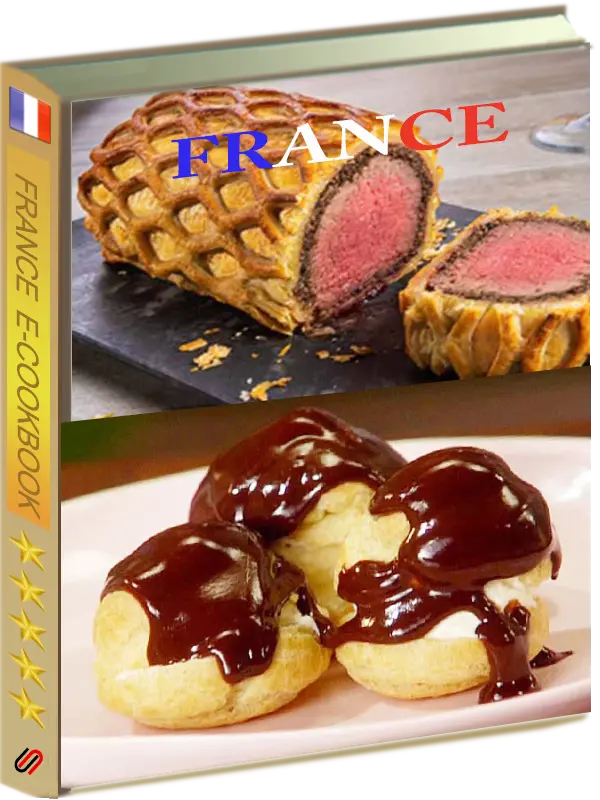The {Page-Turner-Cookbook} featuring
south-korea Is My Kitchen
SOUTH-KOREA Breakfast Appetizers & Soups
SOUTH-KOREA Main Dishes
liquid Measures
Weight & temperature Measures
non-liquid ingredients
Top 5 countries
Last Page
Weight & temperature Measures
non-liquid ingredients
Top 5 countries
Last Page
Traditional Food in South Korea
Kimchi
Kimchi is a bit part of the national identity and is therefore served with pretty much every meal in South Korea. It’s usually made from fermented cabbage and chili, it’s a bit of an acquired taste for travellers.
Korean Barbecue Meal
Korean barbecue has become popular in the west, but health and safety usually means restaurants can’t use a charcoal broiler at the table like they do in South Korea – undoubtedly key to the best flavours. Generally at a barbecue restaurant you’ll find bulgogi, cuts of marinated meat (usually pork or beef), and galbi, ribs that are usually unmarinated. Gimbap – You might think of this as Korean sushi, as it consists of rice, meat or fish, pickled radish, and sesame seeds wrapped up in dried seaweed. The difference from sushi is how the rice is flavoured with salt and sesame oil. A roll of gimbap can be a useful snack to carry with you, but is also an option in a restaurant or cafe.
Soups and stews
Again, the amount of soups and stews you’re likely to encounter in South Korea is ridiculous, and the difference between soup and stew might not always be clear. Soups are known as guk or tang, while jjigae usually means stew. You’ll find soups and stews made with vegetables, kimchi, seafood, meat, tofu, noodles, and more, sometimes all at once. Noodles
It's said that, on average, South Koreans eat 80 bags of ramen noodles per person annually, which is a lot of instant noodles. Most of that ramen is Shin Ramyun (shin means “spicy” in Korean, and ramyun is the Korean word for ramen, a Japanese word).
Noodles are popular in South Korea. Look out for naengmyeon, a thin and chewy buckwheat noodle served in an ice cold beef broth – a Korean speciality. The recipe of the broth can vary heavily from place to place. You’ll also find japchae (yam noodles fried with vegetables, beef, and/or dumplings), ramyeon (Korea’s spicy answer to ramen, served with kimchi), and u-dong (thick wheat noodles similar to Japanese udon).
Seafood
Seafood is massive in South Korea, and many restaurants will have bays of fish tanks containing live specimens for you to choose from.
A traditional South Korean seafood dish is hwe, served raw (similar to sashimi) and flavoured with a hot pepper sauce. Note that in some places the fish will be prepared while still alive to ensure maximum freshness, which can be an altogether unpleasant experience. You could also try haemultang, a spicy hotpot stew made with crab, shrimp, squid, along with vegetables and noodles. Traditional drinks in South Korea
The national drink of South Korea is soju. It’s a bit like vodka (around 20% proof), and you’ll usually find it’s the cheapest beverage on the menu.
Beer
The most popular brands of beer in South Korea are western-style lagers – Cass, Hite and OB.
Kimchi
Kimchi is a bit part of the national identity and is therefore served with pretty much every meal in South Korea. It’s usually made from fermented cabbage and chili, it’s a bit of an acquired taste for travellers.
Korean Barbecue Meal
Korean barbecue has become popular in the west, but health and safety usually means restaurants can’t use a charcoal broiler at the table like they do in South Korea – undoubtedly key to the best flavours. Generally at a barbecue restaurant you’ll find bulgogi, cuts of marinated meat (usually pork or beef), and galbi, ribs that are usually unmarinated. Gimbap – You might think of this as Korean sushi, as it consists of rice, meat or fish, pickled radish, and sesame seeds wrapped up in dried seaweed. The difference from sushi is how the rice is flavoured with salt and sesame oil. A roll of gimbap can be a useful snack to carry with you, but is also an option in a restaurant or cafe.
Soups and stews
Again, the amount of soups and stews you’re likely to encounter in South Korea is ridiculous, and the difference between soup and stew might not always be clear. Soups are known as guk or tang, while jjigae usually means stew. You’ll find soups and stews made with vegetables, kimchi, seafood, meat, tofu, noodles, and more, sometimes all at once. Noodles
It's said that, on average, South Koreans eat 80 bags of ramen noodles per person annually, which is a lot of instant noodles. Most of that ramen is Shin Ramyun (shin means “spicy” in Korean, and ramyun is the Korean word for ramen, a Japanese word).
Noodles are popular in South Korea. Look out for naengmyeon, a thin and chewy buckwheat noodle served in an ice cold beef broth – a Korean speciality. The recipe of the broth can vary heavily from place to place. You’ll also find japchae (yam noodles fried with vegetables, beef, and/or dumplings), ramyeon (Korea’s spicy answer to ramen, served with kimchi), and u-dong (thick wheat noodles similar to Japanese udon).
Seafood
Seafood is massive in South Korea, and many restaurants will have bays of fish tanks containing live specimens for you to choose from.
A traditional South Korean seafood dish is hwe, served raw (similar to sashimi) and flavoured with a hot pepper sauce. Note that in some places the fish will be prepared while still alive to ensure maximum freshness, which can be an altogether unpleasant experience. You could also try haemultang, a spicy hotpot stew made with crab, shrimp, squid, along with vegetables and noodles. Traditional drinks in South Korea
The national drink of South Korea is soju. It’s a bit like vodka (around 20% proof), and you’ll usually find it’s the cheapest beverage on the menu.
Beer
The most popular brands of beer in South Korea are western-style lagers – Cass, Hite and OB.
Appetizer Kimchi 
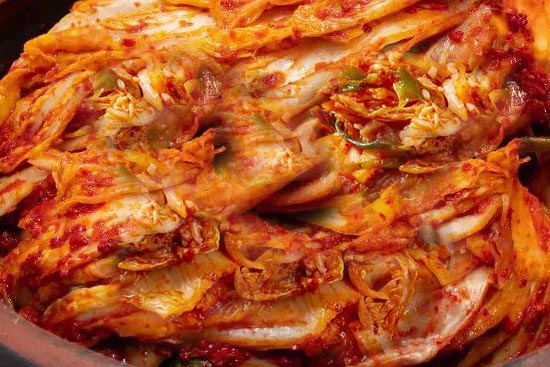
Serves: 4
Preparation time:30 minutes
1 large head napa cabbage1/2 cup kosher salt
1 gallon water
6 cloves garlic, minced
1 1/2 teaspoons minced ginger, peeled
3 tablespoons fish sauce
1 tablespoon cider vinegar
2 teaspoons sugar
1/2 cup Sriracha
6 scallions, both white and green parts, sliced
1 large carrot, peeled and grated
Steps to Make It
Day 1
Gather the ingredients.
Sriracha Kimchi ingredients
Cut cabbage into quarters and then into 1-inch-square pieces. Throw out the core.
Put cabbage into a large nonreactive bowl and toss with salt.
Let cabbage sit for a couple of hours at room temperature.
Add all the water, making sure the cabbage is covered.
Cover and brine at room temperature overnight.
Day 2
Drain the cabbage, rinse it out, and squeeze away any excess moisture.
In a large mixing bowl, add the cabbage and mix with garlic, ginger, fish sauce, vinegar, sugar, Sriracha, scallions, and carrot.
Cover and store at room temperature.
Check the flavor every few days until you get the fermented flavor you like. This typically takes around three to four days at room temperature, or two to three weeks in the refrigerator.
Once it's ready, store in an airtight container in your refrigerator.
Appetizer Peri peri sauce 
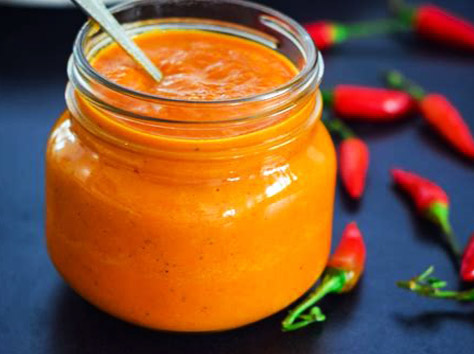
Home-made Peri Peri Sauce is used as dips, accompaniments, marinades or even spreads. This Nandos style Piri Piri Sauce is easy made. PERi-PERi, also known as the African Bird’s Eye Chilli, is the key to our legendary, flame-grilled PERi-PERi chicken. It’s grown in the African soil, so the magic starts from the ground up.
Serves: 8
1 large red onion, char grilled
4 cloves garlic, minced
1/2 cup lemon juice
1/4 cup red wine vinegar, or apple cider vinegar
zest of one lemon, finely grated
10 small red Thai chilis, roughly chopped (more to taste for hotter sauce)
1 1/2 tsp smoked paprika, or plain paprika
1 1/2 tsp dried oregano
2 bay leaves
1 1/2 tsp kosher salt
1 tsp black pepper
To finish the sauce (when cooked)
1/4 cup lemon juice
zest of one lemon, finely minced
1/4 cup red wine vinegar, or apple cider vinegar
1/2 cup extra virgin olive oil
Serves: 8
Preparation time:30 minutes
Cooking time:30 minutes
2 large red bell peppers, char grilled1 large red onion, char grilled
4 cloves garlic, minced
1/2 cup lemon juice
1/4 cup red wine vinegar, or apple cider vinegar
zest of one lemon, finely grated
10 small red Thai chilis, roughly chopped (more to taste for hotter sauce)
1 1/2 tsp smoked paprika, or plain paprika
1 1/2 tsp dried oregano
2 bay leaves
1 1/2 tsp kosher salt
1 tsp black pepper
To finish the sauce (when cooked)
1/4 cup lemon juice
zest of one lemon, finely minced
1/4 cup red wine vinegar, or apple cider vinegar
1/2 cup extra virgin olive oil
Start by roasting the red peppers and onions. This can be done on a gas grill, under the broiler or on a cast iron grill pan. You want to get good char marks on the outside of the peppers and onions. Don't worry if they are not fully cooked, they will get fully cooked in the sauce.
Chop the peppers and onions and add them to a food processor or blender. You can us an immersion blender if that is all you have on hand, just take the time to get the ingredients well pureed.
Add the garlic, lemon juice, red wine vinegar, lemon zest, red Thai chilis, smoked paprika, oregano, salt and pepper to the food processor with the grilled onions and peppers and puree until smooth.
Transfer the sauce to a medium saucepan, add the bay leaves and simmer slowly for 20-30 minutes.
Let the sauce cool to warm. Remove the bay leaves then return the sauce to the food processor again.
Add the additional lemon juice, red wine vinegar and lemon zest. Puree for another few minutes until very smooth. Slowly add in the olive oil in a thin stream as the processor is running.
Chop the peppers and onions and add them to a food processor or blender. You can us an immersion blender if that is all you have on hand, just take the time to get the ingredients well pureed.
Add the garlic, lemon juice, red wine vinegar, lemon zest, red Thai chilis, smoked paprika, oregano, salt and pepper to the food processor with the grilled onions and peppers and puree until smooth.
Transfer the sauce to a medium saucepan, add the bay leaves and simmer slowly for 20-30 minutes.
Let the sauce cool to warm. Remove the bay leaves then return the sauce to the food processor again.
Add the additional lemon juice, red wine vinegar and lemon zest. Puree for another few minutes until very smooth. Slowly add in the olive oil in a thin stream as the processor is running.
Appetizer Seafood green onion pancake haemul-pajeon 

When making pajeon, most Koreans use green onion, and the most popular kind of pajeon is made with seafood. A recipe related to
https://www.maangchi.com
Serves: 2
1 tablespoon potato starch
½ teaspoon kosher salt plus a pinch of salt
a pinch of ground black pepper
¾ cup stock (anchovy kelp stock, chicken stock or vegetable stock), or water
4 tablespoons vegetable oil
12 green onions, roots and tops trimmed to 8 to 9 inches long (to fit your skillet)
4 to 5 ounces (½ cup) seafood (peeled and deveined shrimp, squid, clams), chopped
1 large egg, beaten in a small bowl
1 fresh red pepper, sliced
For dipping sauce:
2 tablespoons soy sauce
1 tablespoon white or apple cider vinegar
½ teaspoon gochu-garu (Korean hot pepper flakes)
1 green onion, chopped
1 teaspoon toasted sesame seeds
Serves: 2
Preparation time:15 minutes
Cooking time:12 minutes
½ cup all-purpose flour1 tablespoon potato starch
½ teaspoon kosher salt plus a pinch of salt
a pinch of ground black pepper
¾ cup stock (anchovy kelp stock, chicken stock or vegetable stock), or water
4 tablespoons vegetable oil
12 green onions, roots and tops trimmed to 8 to 9 inches long (to fit your skillet)
4 to 5 ounces (½ cup) seafood (peeled and deveined shrimp, squid, clams), chopped
1 large egg, beaten in a small bowl
1 fresh red pepper, sliced
For dipping sauce:
2 tablespoons soy sauce
1 tablespoon white or apple cider vinegar
½ teaspoon gochu-garu (Korean hot pepper flakes)
1 green onion, chopped
1 teaspoon toasted sesame seeds
dipping sauce:
1. Put soy sauce, vinegar, gochu-garu, green onion, and sesame seeds in a small bowl.
2. Mix and set it aside.
3. Prepare pancake ingredients:
1. Combine the chopped seafood, pinch of salt and a pinch of ground black pepper in a small bowl. Mix it well and set aside.
2. Combine flour, potato starch, ½ teaspoon salt, and ¾ cup stock (or water) in a large enough to accommodate the green onions. Mix with a whisk until smooth.
Make green onion pancake:
1. Heat 2 tablespoons of the vegetable oil in a large nonstick skillet over medium-high heat and swirl to coat evenly.
2. Add the green onions to the batter to coat them. Using tongs or your hand, place them side by side in the skillet, alternating white end to green end, so they form a neat rectangle.
3. Add the seafood to the leftover batter in the bowl. Using your hands or tongs, spread the battered seafood on top of the battered scallions, scraping out any excess batter remaining in the bowl.
4. Add the sliced red pepper and pour the beaten egg over top of the pancake in the skillet.
5. Quickly wash your hands!
6. Reduce the heat to medium and cook for about 6 minutes, until the bottom is light brown and crispy.
7. Turn the pancake over with a large spatula. Drizzle the remaining 2 tablespoons vegetable oil around the edges of the skillet. Lift one edge of the pancake with your spatula and tilt the skillet so that the oil flows underneath the pancake. Cook for another 3 minutes until nicely browned and crisp.
8. Turn the pancake over again. Turn up the heat to medium high heat and cook for 1 minute, until the bottom turns crunchy.
9. Transfer to a large plate, with the egg and seafood side up. Serve right away with the dipping sauce.
How to eat:
1. Mix the dipping sauce with a spoon. You can cut up the large pancake into several pieces before eating. Take 1 piece to a small individual plate and drizzle some dipping sauce with the spoon and eat. If you don’t want to precut the pancake, you can use your chopsticks to tear off a chunk of batter with a green onion and seafood, and then eat it with the dipping sauce. I prefer the second way because I love to eat the whole cooked green onion.
1. Put soy sauce, vinegar, gochu-garu, green onion, and sesame seeds in a small bowl.
2. Mix and set it aside.
3. Prepare pancake ingredients:
1. Combine the chopped seafood, pinch of salt and a pinch of ground black pepper in a small bowl. Mix it well and set aside.
2. Combine flour, potato starch, ½ teaspoon salt, and ¾ cup stock (or water) in a large enough to accommodate the green onions. Mix with a whisk until smooth.
Make green onion pancake:
1. Heat 2 tablespoons of the vegetable oil in a large nonstick skillet over medium-high heat and swirl to coat evenly.
2. Add the green onions to the batter to coat them. Using tongs or your hand, place them side by side in the skillet, alternating white end to green end, so they form a neat rectangle.
3. Add the seafood to the leftover batter in the bowl. Using your hands or tongs, spread the battered seafood on top of the battered scallions, scraping out any excess batter remaining in the bowl.
4. Add the sliced red pepper and pour the beaten egg over top of the pancake in the skillet.
5. Quickly wash your hands!
6. Reduce the heat to medium and cook for about 6 minutes, until the bottom is light brown and crispy.
7. Turn the pancake over with a large spatula. Drizzle the remaining 2 tablespoons vegetable oil around the edges of the skillet. Lift one edge of the pancake with your spatula and tilt the skillet so that the oil flows underneath the pancake. Cook for another 3 minutes until nicely browned and crisp.
8. Turn the pancake over again. Turn up the heat to medium high heat and cook for 1 minute, until the bottom turns crunchy.
9. Transfer to a large plate, with the egg and seafood side up. Serve right away with the dipping sauce.
How to eat:
1. Mix the dipping sauce with a spoon. You can cut up the large pancake into several pieces before eating. Take 1 piece to a small individual plate and drizzle some dipping sauce with the spoon and eat. If you don’t want to precut the pancake, you can use your chopsticks to tear off a chunk of batter with a green onion and seafood, and then eat it with the dipping sauce. I prefer the second way because I love to eat the whole cooked green onion.
Appetizer Ssamjang korean dipping sauce 

You can store unused portion of ssamjang in an air tight container and refrigerate until needed. From a food safety perspective consume within 3-5 days.
** If you want to learn more about Korean ingredients, see essential Korean grocery ingredients!
Serves: 6
2 Tbsp gochujang (Korean chili paste)
2 Tbsp toasted sesame oil
1/2 Tbsp honey
2 tsp toasted sesame seeds
1/2 tsp minced garlic
10g / 0.35 ounces onion, thinly sliced
(optional) 2 Tbsp walnuts (or your choice of nuts and seeds) – this will add nuttier flavor and creamier texture.
(optional) 10g / 0.35 ounces apple, cored and cut into small pieces
Serves: 6
Preparation time:5 minutes
1/4 cup doenjang (Korean soybean paste)2 Tbsp gochujang (Korean chili paste)
2 Tbsp toasted sesame oil
1/2 Tbsp honey
2 tsp toasted sesame seeds
1/2 tsp minced garlic
10g / 0.35 ounces onion, thinly sliced
(optional) 2 Tbsp walnuts (or your choice of nuts and seeds) – this will add nuttier flavor and creamier texture.
(optional) 10g / 0.35 ounces apple, cored and cut into small pieces
Put all ingredients in a food processor and blend until the texture is smooth. It will takes about 1 min. Transfer the sauce into a serving bowl. Garnish with the green onion and sesame seeds.
Main Bobotie 
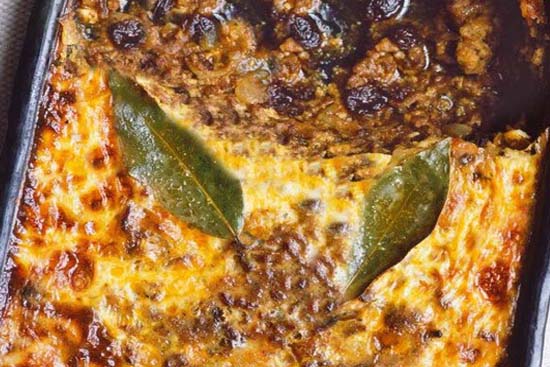
Serves: 6
Preparation time:1 hour 30 minutes
Cooking time:45 minutes
3 slices of bread1 cup + 1/2 cup milk, divided
2 tablespoons olive oil
2 large onions, roughly chopped
4 teaspoons medium curry powder
1 teaspoon dried herbs (oregano, basil, marjoram)
1 teaspoon ground cumin
1/2 teaspoon ground turmeric
2 garlic cloves, finely chopped
1 1/2 pound ground beef or lamb
1/2 cup fruit chutney
3 tablespoons sultana raisins
Zest and juice of one medium lemon, divided
4 teaspoons tomato paste
Salt and pepper
2 large eggs
4 bay leaves
Preheat your oven to 350°F.
Soak the bread in 1 cup of milk.
Heat the olive oil in a wide skillet set over medium heat. Once the oil is hot, add the onions, and cook until soft.
Add the curry powder, mixed herbs, ground cumin, turmeric, and garlic, and stirring constantly, allow to cook for a minute or two until the garlic is soft.
Add the ground meat, and cook, stirring frequently to break up any big chunks, until browned.
Once the meat is browned, remove the skillet from the heat, and stir in the chutney, raisins, all the lemon zest, half the lemon juice, tomato paste, and salt and pepper to taste. Mix well, give it a taste, and add more lemon juice, salt, and pepper as desired.
Squeeze the milk from the bread, reserving the milk for later, and tearing the bread into small pieces. Mix the bread into the beef mixture, and spread evenly into an oven-proof dish.
Strain the milk that has come from the bread, and add the remaining 1/2 cup of milk. Beat in the eggs, and season with 1/4 teaspoon salt and pepper to taste. Pour this over the meat, and scatter the bay leaves on top.
Bake, uncovered, at 350°F for 45 minutes, or until golden brown.
Soak the bread in 1 cup of milk.
Heat the olive oil in a wide skillet set over medium heat. Once the oil is hot, add the onions, and cook until soft.
Add the curry powder, mixed herbs, ground cumin, turmeric, and garlic, and stirring constantly, allow to cook for a minute or two until the garlic is soft.
Add the ground meat, and cook, stirring frequently to break up any big chunks, until browned.
Once the meat is browned, remove the skillet from the heat, and stir in the chutney, raisins, all the lemon zest, half the lemon juice, tomato paste, and salt and pepper to taste. Mix well, give it a taste, and add more lemon juice, salt, and pepper as desired.
Squeeze the milk from the bread, reserving the milk for later, and tearing the bread into small pieces. Mix the bread into the beef mixture, and spread evenly into an oven-proof dish.
Strain the milk that has come from the bread, and add the remaining 1/2 cup of milk. Beat in the eggs, and season with 1/4 teaspoon salt and pepper to taste. Pour this over the meat, and scatter the bay leaves on top.
Bake, uncovered, at 350°F for 45 minutes, or until golden brown.
Main Chicken salad 
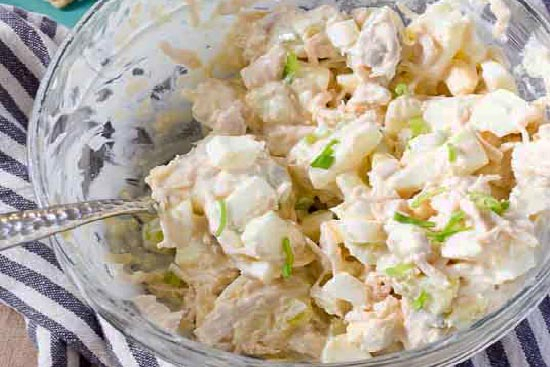
Serves: 4
Preparation time: 15 minutes
Cooking time:None
12 ounces cooked chicken 4 ounces diced celery
20 pieces pecans
1 diced shallot
2 hard cooked eggs, chopped
1 teaspoon lemon juice
1/2 cup mayonnaise
salt and white pepper to taste
8 leaves lettuce
Dice chicken. Combine with celery, nuts, shallots,chopped hard cooked eggs, and lemon juice.
Fold in mayonnaise and season with salt and pepper. Serve on lettuce leaf.
Fold in mayonnaise and season with salt and pepper. Serve on lettuce leaf.
Main Korean honey sesame grilled chicken 

Serves: 6
Preparation time:25 minutes
Cooking time:15 minutes
For the rub:1½ tablespoons extra virgin olive oil
1 tablespoon sweet paprika
1 teaspoon garlic salt
½ teaspoon sugar
For the glaze/sauce:
½ cup low sodium soy sauce
¼ cup honey
2 tablespoons hoisin sauce
1½-3 tablespoons Korean Gochujang to taste
2 tablespoons finely grated fresh ginger
2 tablespoons sesame oil
2 garlic cloves, finely minced
1 ½ tablespoon grainy mustard
1 tablespoon sesame seeds, more for garnish, if desired
For the chicken:
2 pounds trimmed boneless skinless chicken thighs or chicken breasts
For the rub:
Combine olive oil, paprika, garlic salt, and sugar in a medium size bowl. Stir well to combine then add the chicken and turn several times to coat. I like to use my hands to massage the rub into the chicken.
Cover the bowl and refrigerate for at least 30 minutes or as long as 24 hours.
For the glaze/sauce
Combine all ingredients in a medium-size sauce pan and stir well. Bring to a boil and cook for 5 -7 minutes, until sauce thickens and is reduced by about one half. (Maintain a steady, medium boil but reduce the heat a bit if the mixture boils up too high.) Taste and if you’d like it a little spicier, add another tablespoon of Gochujang. Repeat to taste. Set aside to cool down.
For grilling the chicken:
Heat a grill to high (500-600˚F). Clean and oil the grates.
Place the chicken on the grill; cook for 3-4 minutes on the first side, or until golden brown. Flip to the opposite side and brush the cooked side with some of the glaze. Grill the second side for 3-4 minutes then flip and brush with the glaze. Continue cooking for 1-2 minutes more on each side, brushing with the glaze after flipping until the chicken is browned and nicely charred in spots.
Transfer the chicken to a serving platter and allow to rest for a few minutes before slicing. Serve any extra sauce with the chicken.
Combine olive oil, paprika, garlic salt, and sugar in a medium size bowl. Stir well to combine then add the chicken and turn several times to coat. I like to use my hands to massage the rub into the chicken.
Cover the bowl and refrigerate for at least 30 minutes or as long as 24 hours.
For the glaze/sauce
Combine all ingredients in a medium-size sauce pan and stir well. Bring to a boil and cook for 5 -7 minutes, until sauce thickens and is reduced by about one half. (Maintain a steady, medium boil but reduce the heat a bit if the mixture boils up too high.) Taste and if you’d like it a little spicier, add another tablespoon of Gochujang. Repeat to taste. Set aside to cool down.
For grilling the chicken:
Heat a grill to high (500-600˚F). Clean and oil the grates.
Place the chicken on the grill; cook for 3-4 minutes on the first side, or until golden brown. Flip to the opposite side and brush the cooked side with some of the glaze. Grill the second side for 3-4 minutes then flip and brush with the glaze. Continue cooking for 1-2 minutes more on each side, brushing with the glaze after flipping until the chicken is browned and nicely charred in spots.
Transfer the chicken to a serving platter and allow to rest for a few minutes before slicing. Serve any extra sauce with the chicken.
Main Potjie stew 

Potjiekos, which translates to small pot food recipe comes from Namibia and South Africa and is their version of a traditional stew with meat, starch, and veggies or whatever they had on hand and in season.
Serves: 4
3 onions, chopped
1 fresh chili pepper, finely chopped
3 garlic cloves, crushed
1 pound of fresh mushrooms, whole
2 pounds stewing beef (bone on), cut into chunks
1 pound mixture of your favorite beans: sugar beans, red kidney beans, white kidney beans, haricot beans, black-eyed beans, all work well.
If using dried beans, soak overnight. If canned, drain and rinse before adding them to the pot.
4 carrots, roughly chopped, and other seasonal vegetables of your choice
12 baby potatoes
2 cans of creamed corn (mealies)
2 cups beef stock
Mixed herbs to your taste (about 3 tablespoons). like thyme, oregano, and rosemary, but feel free to experiment.
Salt and pepper to taste
1/2 cup red wine (optional)
Serves: 4
Preparation time:30 minutes
Cooking time:2 hours
2 tablespoons butter or oil3 onions, chopped
1 fresh chili pepper, finely chopped
3 garlic cloves, crushed
1 pound of fresh mushrooms, whole
2 pounds stewing beef (bone on), cut into chunks
1 pound mixture of your favorite beans: sugar beans, red kidney beans, white kidney beans, haricot beans, black-eyed beans, all work well.
If using dried beans, soak overnight. If canned, drain and rinse before adding them to the pot.
4 carrots, roughly chopped, and other seasonal vegetables of your choice
12 baby potatoes
2 cans of creamed corn (mealies)
2 cups beef stock
Mixed herbs to your taste (about 3 tablespoons). like thyme, oregano, and rosemary, but feel free to experiment.
Salt and pepper to taste
1/2 cup red wine (optional)
Braise onions and mushrooms in butter and flavored salt (Ah, the sizzle! The aroma!)
Add chili and garlic, sauté for 2 minutes. Try not to eat it yet.
Add beef, cover the pot, and let it steam for 5 minutes. No peeking!
Toss in carrots, potatoes, and other veggies. Cover and let steam for 5 minutes.
Add beans, sweet corn, beef stock, mixed herbs, and the red wine. Cover the pot.
Simmer for about 20 minutes. Stir well.
Cook for 1-2 hours, or until the meat is tender Add the mushrooms about 20 minutes before serving.
Serve over rice or pasta. Or use crusty loaf of freshly baked bread.
Add chili and garlic, sauté for 2 minutes. Try not to eat it yet.
Add beef, cover the pot, and let it steam for 5 minutes. No peeking!
Toss in carrots, potatoes, and other veggies. Cover and let steam for 5 minutes.
Add beans, sweet corn, beef stock, mixed herbs, and the red wine. Cover the pot.
Simmer for about 20 minutes. Stir well.
Cook for 1-2 hours, or until the meat is tender Add the mushrooms about 20 minutes before serving.
Serve over rice or pasta. Or use crusty loaf of freshly baked bread.
Main Singapore noodles 
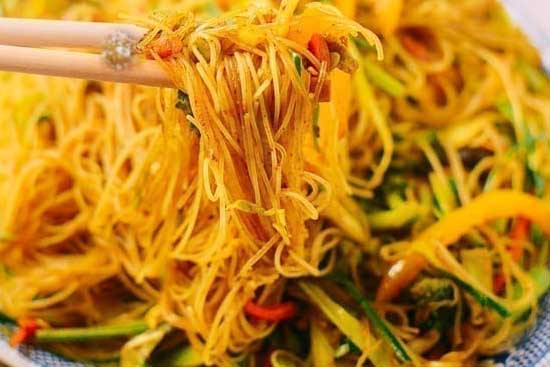
Serves: 4
Preparation time:15 minutes
Cooking time:15 minutes
8 oz vermicelli rice noodles1 tbsp mild curry powder
¼ tsp turmeric
1 tsp sugar
1 tbsp sesame oil
3 tbsp low-salt soy sauce
1 tbsp vegetable oil
1 cup sliced onion
1 sweet pepper, yellow or orange
6 oz bean sprouts
1 red chilli, sliced (optional)
Soften the noodles in a large pan of boiling water to cover, pushing the noodles under the water. Set aside for 5-10 minutes, until the noodles are completely soft. Mix the curry powder, turmeric, sugar, sesame oil, soy sauce and 1 tbsp water in a bowl.
Heat a wok until very hot. Add the sunflower oil, onion and pepper. Stir-fry for 3-4 minutes until softened and starting to brown in places. Drain the noodles and add to the pan, along with the sauce mixture and bean sprouts. Stir-fry for a further 3-4 minutes, tossing everything through the sauce, until hot. Adjust the seasoning with a little more soy or sugar, if you like, and scatter over the chilli, if you like more spice.
Heat a wok until very hot. Add the sunflower oil, onion and pepper. Stir-fry for 3-4 minutes until softened and starting to brown in places. Drain the noodles and add to the pan, along with the sauce mixture and bean sprouts. Stir-fry for a further 3-4 minutes, tossing everything through the sauce, until hot. Adjust the seasoning with a little more soy or sugar, if you like, and scatter over the chilli, if you like more spice.
conversion of liquids
Weights
Temperatures
Measures of non liquid ingredients
Non-liquid ingredients in volume converted
|
|||||||
|---|---|---|---|---|---|---|---|
Ingredient |
1 cup |
3/4 cup |
2/3 cup |
1/2 cup |
1/3 cup |
1/4 cup |
2 tablespoons |
| All-purpose wheat flour | 120 g | 90 g | 80 g | 60 g | 40 g | 30 g | 15 g |
| All-purpose sifted wheat flour | 110 g | 80 g | 70 g | 55 g | 35 g | 27 g | 13 g |
| White sugar | 200 g | 150 g | 130 g | 100 g | 65 g | 50 g | 25 g |
| Powdered sugar/Icing sugar | 100 g | 75 g | 70 g | 50 g | 35 g | 25 g | 13 g |
| Brown sugar normally packed | 180 g | 135 g | 120 g | 90 g | 60 g | 45 g | 23 g |
| Corn flour | 160 g | 120 g | 100 g | 80 g | 50 g | 40 g | 20 g |
| Cornstarch | 120 g | 90 g | 80 g | 60 g | 40 g | 30 g | 15 g |
| Rice (not-cooked) | 190 g | 140 g | 125 g | 95 g | 65 g | 48 g | 24 g |
| Macaroni (uncooked) | 140 g | 100 g | 90 g | 70 g | 45 g | 35 g | 17 g |
| Couscous (uncooked) | 180 g | 135 g | 120 g | 90 g | 60 g | 45 g | 22 g |
| Quick oatmeal (uncooked) | 90 g | 65 g | 60 g | 45 g | 30 g | 22 g | 11 g |
| Table salt | 300 g | 230 g | 200 g | 150 g | 100 g | 75 g | 40 g |
| Butter / Margarine | 240 g | 180 g | 160 g | 120 g | 80 g | 60 g | 30 g |
| Shortening | 190 g | 140 g | 125 g | 95 g | 65 g | 48 g | 24 g |
| Fruits and légumes chopped | 150 g | 110 g | 100 g | 75 g | 50 g | 40 g | 20 g |
| chopped walnuts | 150 g | 110 g | 100 g | 75 g | 50 g | 40 g | 20 g |
| Nuts /ground almonds | 120 g | 90 g | 80 g | 60 g | 40 g | 30 g | 15 g |
| Fresh bread crumbs (not packed) | 60 g | 45 g | 40 g | 30 g | 20 g | 15 g | 8 g |
| Dry bread crumbs | 150 g | 110 g | 100 g | 75 g | 50 g | 40 g | 20 g |
| Parmesan grated | 90 g | 65 g | 60 g | 45 g | 30 g | 22 g | 11 g |
| Chocolate chips | 150 g | 110 g | 100 g | 75 g | 50 g | 38 g | 19 g |

As the sun rises or sets in
SOUTH-KOREA
"May every sunrise hold more promise, and every sunset hold more peace."
The {Page Turner} E-Cookbooks
Library on a world cooking journey
9 Recipes
4 Appetizers
5 Main dishes








